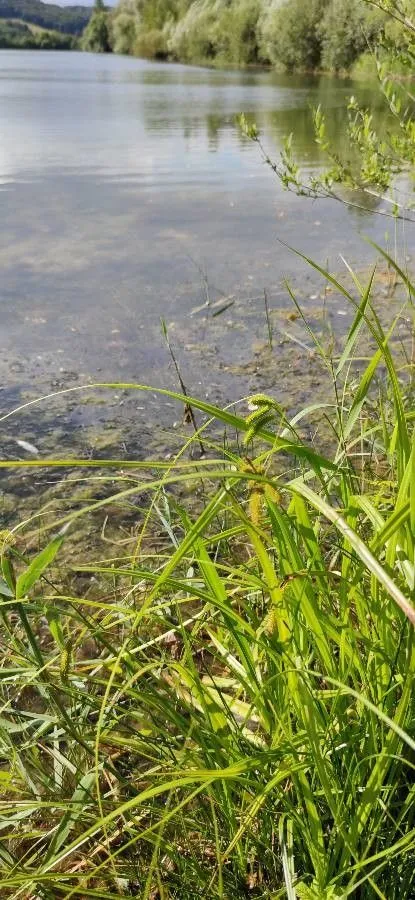
Author: L.
Bibliography: Sp. Pl.: 978 (1753)
Year: 1753
Status: accepted
Rank: species
Genus: Carex
Vegetable: False
Observations: Temp. & Subtrop. Northern Hemisphere to Philippines, New Zealand
Cypress-like sedge, scientifically known as Carex pseudocyperus, is a distinctive member of the Cyperaceae family. First described by the eminent botanist Carl Linnaeus in 1753 in his work Species Plantarum, this species holds a broad geographic range. It thrives in temperate and subtropical regions across the Northern Hemisphere, with its presence spanning from the cooler climates to as far south as the Philippines and New Zealand.
Carex pseudocyperus is an intricate and visually appealing sedge that often evokes the graceful appearance reminiscent of cypress trees, hence its common name. The plant typically inhabits wetland environments, including marshes, swamps, and the edges of freshwater bodies. Its adaptation to such habitats allows it to contribute significantly to the local ecosystem, providing cover and food for various species of wildlife.
Characterized by its tall and slender form, Carex pseudocyperus boasts linear leaves and stems that can reach impressive heights. The plant exhibits unique flower spikes, which are pivotal for its reproduction. The inflorescences are arranged in a manner that is not only functional for its reproductive success but also adds to its ornamental value, making it a subject of interest for both botanists and gardening enthusiasts.
In ecological terms, Carex pseudocyperus plays a crucial role in maintaining the health of wetland areas. Its root systems help stabilize soils, reducing erosion, while the plant as a whole aids in water filtration, improving the quality of the ecosystem. Furthermore, it provides habitat and nourishment for local fauna, making it an integral component of the biological community.
Through its wide distribution and ecological significance, Carex pseudocyperus exemplifies the intricate web of plant life that sustains wetland environments around the globe. Its study and conservation are essential for both preserving biodiversity and understanding the complex interactions within these critical habitats.
Eng: cyperus sedge, cypress-like sedge, cyperus-like sedge, false bristly sedge, hop sedge
Nor: dronningstarr
Dan: knippe-star
Deu: scheinzypergras-segge, zypergrassegge
Nob: dronningstarr
Nno: dronningstorr
Nld: hoge cyperzegge
Fra: laîche faux souchet, carex faux-souchet, laîche faux-souchet
Swe: slokstarr, varstasara
Fin: varstasara
Ita: carice falso-cìpero
Cym: hesgen gynffonnog, hesgen hopysaidd
En: Cypress-like sedge, Cyperus Sedge, Cyperus-like sedge, Hop Sedge, False bristly sedge, Cypresslike Sedge
Be: Асака ілжывая сыць
Zh: 似莎薹草
Cs: Ostřice nedošáchor
Da: Knippe-star
Nl: Hoge cyperzegge
Et: Kraavtarn
Fi: Varstasara
Fr: Laîche Faux Souchet, Laîche faux-souchet, Carex faux-souchet, Laiche faux souchet
De: Scheinzypergras-Segge, Zypergrassegge, Cypergras-Segge
He: כריך גומאי
It: Carice falso-cipero, Carice Falso-cìpero, Carice falso cípero
Lv: Dižmeldru grīslis
No: Donningstorr, Dronningstarr
Nb: Dronningstarr
Nn: Dronningstorr
Fa: کارکس پسدوکیپروس
Pl: Turzyca nibyciborowata
Ru: Осока ложносытевая
Sv: Slokstarr, Varstasara
Uk: Осока несправжньосмикавцева
Cy: Hesgen Gynffonnog, Hesgen Hopysaidd
Taken Jun 21, 2017 by Yoan MARTIN (cc-by-sa)
Taken Jul 21, 2013 by Tela Botanica − Emmanuel STRATMAINS (cc-by-sa)
Taken Jun 22, 2020 by louis melin (cc-by-sa)
Taken Jul 12, 2014 by Tela Botanica − Jean-Claude ECHARDOUR (cc-by-sa)
Taken Aug 7, 2021 by Daniel Bourget (cc-by-sa)
Taken Jul 29, 2017 by Tela Botanica − Liliane ROUBAUDI (cc-by-sa)
Taken Jul 29, 2017 by Tela Botanica − Liliane ROUBAUDI (cc-by-sa)
Taken Aug 25, 2019 by Rudolf Krönung (cc-by-sa)
Taken Aug 7, 2021 by Daniel Bourget (cc-by-sa)
Taken Aug 7, 2021 by Daniel Bourget (cc-by-sa)
Taken May 18, 2022 by Gaël Covain (cc-by-sa)
Taken Jun 21, 2017 by Yoan MARTIN (cc-by-sa)
Taken Aug 2, 2020 by James Bethel (cc-by-sa)
Taken Jun 2, 2020 by thomas e (cc-by-sa)
Taken May 4, 2022 by Marylaure Lecouteux (cc-by-sa)
Taken Aug 18, 2020 by Patrick Nard (cc-by-sa)
Taken Jul 22, 2022 by Michel Ambroise (cc-by-sa)
Taken Jul 29, 2017 by Tela Botanica − Liliane ROUBAUDI (cc-by-sa)
Taken Jul 29, 2017 by Tela Botanica − Liliane ROUBAUDI (cc-by-sa)
Taken Jul 29, 2017 by Tela Botanica − Liliane ROUBAUDI (cc-by-sa)
Taken Aug 15, 2000 by Photoflora – Benoit BOCK (©)
Taken May 15, 1995 by Photoflora – Benoit BOCK (©)
Taken May 15, 2015 by Photoflora – Jean-Luc TASSET (©)
Taken Jun 6, 1851 by Tela Botanica − Herbier PONTARLIER-MARICHAL (cc-by-sa)
Taken Jan 1, 1970 by Photoflora – L’Abbé COSTE (©)
Growth habit: Graminoid
Ph maximum: 8.0
Ph minimum: 7.5
Light: 6
Atmospheric humidity: 9
Bloom months: [‘may’, ‘jun’, ‘jul’]
Soil nutriments: 5
Family: Myrtaceae Author: (F.Muell.) K.D.Hill & L.A.S.Johnson Bibliography: Telopea 6: 402 (1995) Year: 1995 Status:…
Family: Rubiaceae Author: Pierre ex A.Froehner Bibliography: Notizbl. Bot. Gart. Berlin-Dahlem 1: 237 (1897) Year:…
Family: Sapindaceae Author: Koidz. Bibliography: J. Coll. Sci. Imp. Univ. Tokyo 32(1): 38 (1911) Year:…
Family: Asteraceae Author: A.Gray Bibliography: Pacif. Railr. Rep.: 107 (1857) Year: 1857 Status: accepted Rank:…
Family: Fabaceae Author: Medik. Bibliography: Vorles. Churpfälz. Phys.-Ökon. Ges. 2: 398 (1787) Year: 1787 Status:…
Family: Aspleniaceae Author: (Cav.) Alston Bibliography: Bull. Misc. Inform. Kew 1932: 309 (1932) Year: 1932…